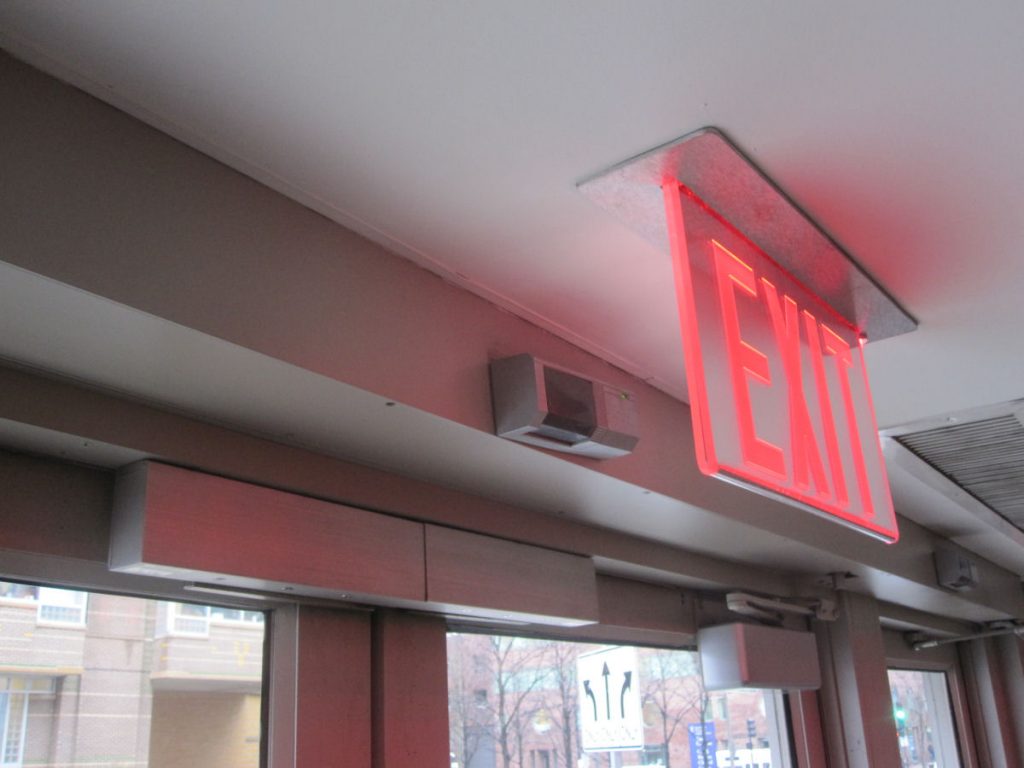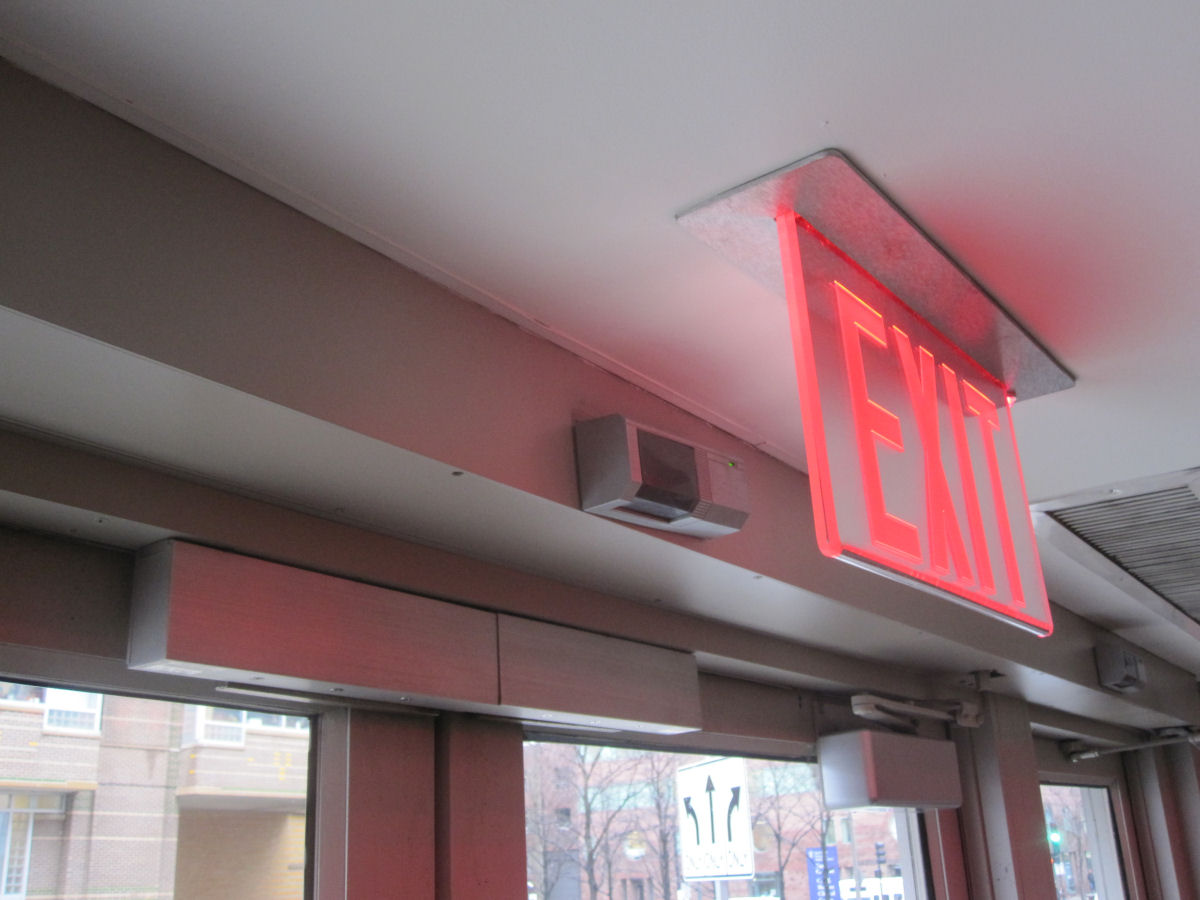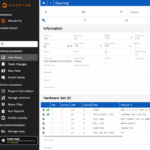I posted this photo a loooong time ago, and this issue has come up several times lately. When I took the photo, the sensor did not unlock the electromagnetic lock until I actually touched the door and the movement of my hand triggered the sensor. It seems obvious that the sensor should not be positioned behind the exit sign (or any obstruction), but when the issue is pointed out to the facility manager, he or she will often ask where they can find the guidelines for sensor placement.
posted this photo a loooong time ago, and this issue has come up several times lately. When I took the photo, the sensor did not unlock the electromagnetic lock until I actually touched the door and the movement of my hand triggered the sensor. It seems obvious that the sensor should not be positioned behind the exit sign (or any obstruction), but when the issue is pointed out to the facility manager, he or she will often ask where they can find the guidelines for sensor placement.
Taking a step back to make sure we’re all on the same page…there are two code sections that address electromagnetic locks in order to allow free egress. One section covers electromagnetic locks that are released by hardware that’s mounted on the door – like panic hardware with a request-to-exit (RX) switch. The other section covers electromagnetic locks that are released by a sensor which detects an approaching occupant and unlocks the door. Both sections include other requirements, and there is more information in this article.
In NFPA 101 – The Life Safety Code and editions of the International Building Code (IBC) prior to the 2015 edition, the section that addresses the mag-lock application with the sensor is called Access-Controlled Egress Doors. Because there was confusion about whether this section applies to every door with an access-control reader (it doesn’t!), the name of the section was changed in the 2015 edition of the IBC. It is now called Sensor Release of Electrically Locked Egress Doors.
With this type of system, NFPA 101 and the IBC require a sensor which detects an approaching occupant and unlocks the door. With regard to the sensor, the IBC says: “The sensor shall be installed on the egress side, arranged to detect an occupant approaching the doors. The doors shall be arranged to unlock by a signal from or loss of power to the sensor.” NFPA 101 says: “A sensor shall be provided on the egress side, arranged to unlock the door leaf in the direction of egress upon detection of an approaching occupant.”
I am positive that the intent of this requirement is for the mag-lock to release AS SOMEONE IS APPROACHING THE DOOR, not when someone runs into the still-locked door and they are finally detected by the sensor. But the codes don’t currently include prescriptive requirements as to the type of sensor, the detection range, or the timing of the door release. When a facility manager asks me for evidence of why it’s not acceptable for the door to remain locked until someone is standing under the sensor touching the door or waving at the sensor, all I have is the code language above.
Here’s my question for you. Other than common sense and an understanding of what the likely intent of the code is, what else can I use to demonstrate any sort of standard pattern for the sensor’s detection area? Any best practices or default detection zones? Patterns that show up in the installation instructions for various products? The 2015 IBC Commentary supports my opinion that the door should unlock when the occupant is APPROACHING the door (not standing at the door):
“Item 1 requires that such doors be provided with an occupant sensor on the egress side of the door. These sensors typically operate on an infrared, microwave or sonic principle, but other technologies may be available. This sensor is required to automatically release the electrical lock on approach of an occupant from the egress side or when there is a loss of power to the sensor. This provision is written as “performance-based,” where any means of sensor design can be utilized to cause the doors to unlock, allowing immediate egress. This section does not indicate at what distance the sensor should be set to operate. The sensor may be set to detect an approaching occupant in time to unlock the electrical locks prior to the occupant reaching the door, to permit egress without the occupant realizing the doors were electrically locked. In other applications, the sensor may be set to require the occupant to be closer to the door prior to unlocking the electrical lock to allow egress.”
Any other ideas for supporting documentation? WWYD?
You need to login or register to bookmark/favorite this content.






IBC 2015,
This section?
1010.1.9.8 Sensor release of electrically locked egress doors.
I am thinking might be an ahj approval, as to how close you have to be, for the lock to release.
I think my call would be three feet. No basis for that distance, except that is my zone for a lot of calls, such as displays around exit doors. Normally I tell a person the clear width of the door, clear.
Lori, it seems like there are many motion sensing products that are specifically designed to do what you are concerned about in this article. See the pictures shown for this device: http://www.securitron.com/Other/Securitron/_OWNA2.0/Documents/Catalog/2016/Access_Control/Catalog2016_XMS.pdf
And this: http://www.beainc.com/wp-content/themes/bea/documents/79.0023.13%20R2E-100%2020170110.pdf
Is there a place that you would say these applications are acceptable?
Just a thought. If I have to wave my hand or touch the door in order for it to unlock, and then I have to operate the unlatching mechanism. To me that is two motions and the code requires the door must be operable with a single motion.
I suggest we should thing of the sensor as similar to delay egress, performing a positive action such as touching the door is sufficient to release the magnate lock, or similar to electromagnetic locks that are released by hardware that’s mounted on the door – like panic hardware with a request-to-exit (RX) switch.
One of my peeves is door sensors that opens a door as you are going by not through, the same goes for light sensors that turn lights on when the is sufficient light and you are just passing through an area.
If one does some Google research on lawsuits involving doors, they will find that injuries from various automatic door equipment should provide plenty of motivation beside trying to pleasing a code official. My brief research tells me that you do not want a door that is expected to get out of the way not do so (in my case probably hitting me in the nose) or have one close unexpectedly. The door opening must be part of the means of egress “that allows free, unimpeded egress to the public way.” I checked IBC, NFPA and that often forgotten OSHA for definitions. I also checked legal sites but came away with things like “Keep back 1,500 feet upon the approach of a train” or “please approach the bench”. The speed of approach, the distance people must be warned is so variable that I don’t think any phrase will capture the situation sufficiently. This is a case of the “code of common sense”. Facility people should always be aware of any injury and figure out how to prevent further incidents. The law suits get clues like you should inspect the equipment daily for safety when you unlock and activate it, have competent inspection and repairs, etc.
doesn’t code also require a redundant way to cut power, such as a secondary push button or something that kills power to mag in case sensor doesn’t work, also to be within 5 ft of door?
Hi Richard –
Yes – the push button is required for locks released by a sensor.
– Lori
Just a thought.
I human at a brisk walk will cover about 6’/second. (4mph) At a run, about 15’/second. (10mph) At a full on sprint maybe 22’/second (15mph). Using these types of figures, could a criteria be developed to say how far away from the door the detection would be triggered? I have no idea what percentage of people move at those rates, or even if the rates could be changed depending on the type of occupancy. There are probably many other considerations, such as mass of the moving body, or height but it seems to make sense that having a definite criteria is better for everybody. So by this type of criteria, if a standard distance was set and when you approached it did not activate at or before that disatnce, it would not be compliant. Outside of that it may not matter how or where the sensor is used.
A similar argument can be made about the location of the exit sign in relationship to the door. Codes do not prescribe exact placements, but I would think the exit sign location would take priority over the sensor location. The exit sign required rough-in work meaning a back box and conduit, while the sensor (low voltage) has no code required rough-in and can be placed where it is not blocked by another object. It is my understanding that the two items are installed by different trades – electrical and security. They should be coordinated.
Doesn’t the manufacturer of the sensor indicate what clearance is required for the door to function as designed? If not, it should. As a regulator, that’s the first place I look.
How about a flush mount sensor in the ceiling in front of the sign?